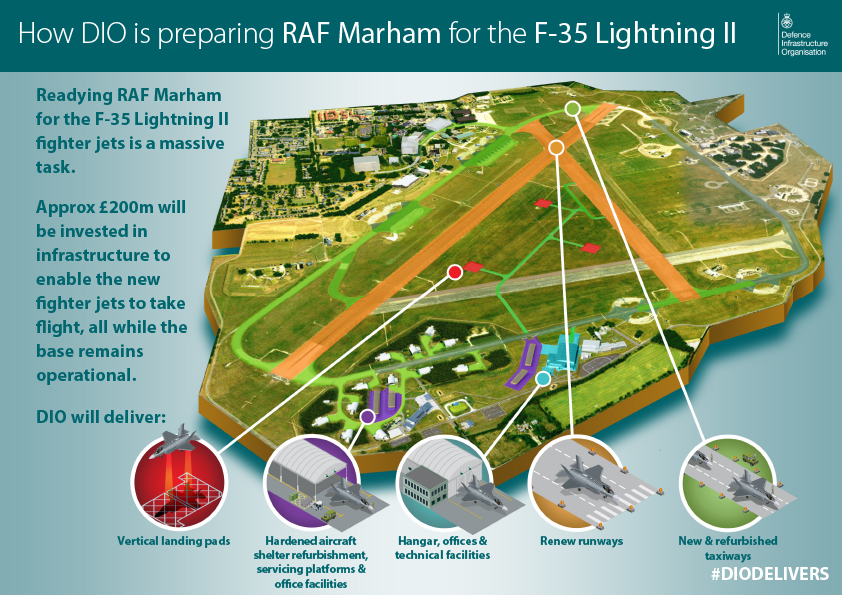2017-04-13 By Robbin Laird
During my visit to the United Kingdom in March 2017, I had a chance to visit RAF Marham.
My host for the visit was Captain Nick Walker of the Royal Navy and we had the opportunity to view the various buildings in progress on the base as well as to receive a briefing from Commander John Butcher, the Chief of Staff at the Lightning Force Headquarters, and the commander of the first F-35B squadron to operate in the United Kingdom, which arrives next year.
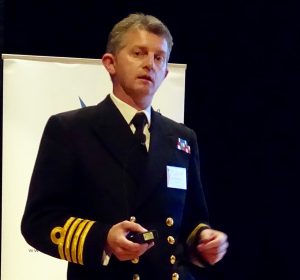 Captain Nick Walker, Royal Navy, presenting at the Williams Foundation Seminar on Air Sea Integration, Canberra, August 10, 2016
Captain Nick Walker, Royal Navy, presenting at the Williams Foundation Seminar on Air Sea Integration, Canberra, August 10, 2016
I also received a briefing and had a chance to discuss the standup of the infrastructure with the impressive team supporting the establishment of the F-35B at Marham.
There is a staff of 17 at the Lightning Force headquarters supporting the operational standup with nine specifically focused on the infrastructure aspects.
They are busy simply in order to have the base ready next year to receive their first contingent of F-35Bs from their current base, which is in the United States.
The base will have a fully operational, training and support capability.
Training, maintenance and various centers are being stood up.
At the heart of the effort will be the National Operations Center in which logistics and operations are collocated and the U.S. will have personnel in this center as well.
According to Wing Commander Butcher: “Within the National Operating Center, you essentially have two main functions. There’s what we’re calling the Logistics Operating Center, and the Lightning Force Headquarters.
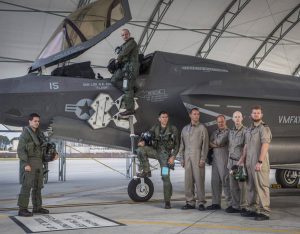
“The two of those together create the National Operating Center. Within the Logistics Operating Center, or the LOC, you have some very key elements of the Lightning project team that are currently based out of Abbeywood.
“The people who are doing the engineering supervision, the acquisition of the facilities, acquisition of the parts, the management of the supply chain, many of these will move to Marham and will sit alongside key industry partners.
“We have as well the Lightning Force Headquarters built within that same facility. Now if you plug in the USAF into that as well, which is our plan right now, then you have a very joint UK F-35 outlook with regard to the entire enterprise.”
There are multiple synergies involved with the F-35 and the standup of the Marham Air Base.
The first is the synergy from America to the United Kingdom and back again.
The UK has operators at Pax River, Edwards, Eglin and Beaufort Marine Corps Air Station.
17 Squadron at Edwards is a Test and Evaluation squadron and because the F-35 is a software upgradeable aircraft, tests will be a fact of life as the capabilities of the aircraft evolve over time, and the Brits are well placed at Edwards to be participants in this process. It should also be noted that the Dutch are on the ground floor with the Brits in this process as well as the Aussies.
The UK and the USMC are fully pooled at Beaufort with Marines flying British planes and vice versa. While there the Brits use the US Navy logistics system to support the F-35B whereas at Edwards they use the British system, so are learning how to work within both systems.
The Eglin engagement with the Canadians and Australians involved is with the reprogramming lab. “In effect, this is the apps center for the evolution of the software,” according to Commander Butcher.
According to Wing Commander Bucher, the build up at Beaufort will continue until mid-2018 when personnel will gradually transfer to Edwards or other facilities in the United States or come back to the UK.
“We will peak out at about 200 persons at Beaufort. We will bring 9 of our jets back next summer and five more later in the year.”
All of these bases are key elements in the UK element of the F-35 global enterprise.
The planes coming from Beaufort will provide the standup for the first RAF squadron. 617 squadron will be stood up next year as the Brits move from Beaufort to Marham.
The second synergy is between the standup among bases and lessons learned.
Marham is being stood up and generating operational lessons learned back to the United States, both in terms of the U.S.’s standup of its own bases abroad and at home, and, notably in terms of shaping a new operational dynamic for RAF Lakenheath.
The USAF F-35s at Lakenheath can become integrated into the operational, training and support elements in the UK as well, shaping a new approach for the USAF as well.
As Wing Commander Butcher underscored the possibilities:
“We want to take forwards everything that we’ve done in the pooling and implementation agreement in the United States, and try and see how we can transpose that into a UK model.
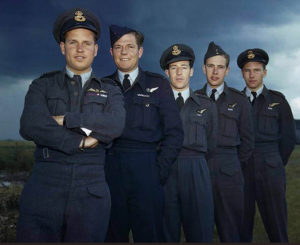
“We’re looking to have jets taking off, F-35A’s taking off at Lakenheath. Well, what if they have an issue and they need to land in Marham. Rather than take the time to move people, spares etc from Lakenheath up to here, what’s to say that we couldn’t conceptually have some maintainers from 617 Squadron repair the jet, sign off, send it flying again.
“Lakenheath is going to be busy base with the closure of Mildenhall. Increased efficiencies working with us would make sense.
“Could we potentially have F-35As operating out of Marham on a daily basis?
“How do we organize hot pit operations on each other’s base?
“One can easily see how that could buy you a lot of combat flexibility, in terms of how you might do maintenance operations.”
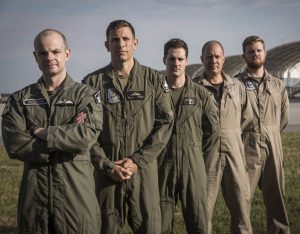
Commander Butcher noted that in the working group with Lakenheath, a 06-level maintainer is embedded in the UK Lightning Force Headquarters.
“He’s come in to do the interim scoping for how we might integrate the USAF into the Lightning Force headquarters facility, in particular the National Operating Center.”
Embedded in this synergy is a close working relationship with the USMC as well which can be seen at Beaufort or on the LHAs preparing for F-35B operations.
There is also a close working relationship between the new carrier community in the UK and with the US Navy as many UK officers have trained and operated aboard US carriers learning the US approach to the use of carriers, and shaping their thinking as well with regard to shaping their own approach to carrier operations with the F-35B.
The third synergy is between the Royal Navy and the Royal Air Force.
The UK is standing up a Lightning Force, not a RAF or Royal Navy force. The first two squadrons are being established on a 58/42 basis between RAF and RN pilots.
The first squadron, which will start the move from Beaufort in mid-2018 with full IOC by the end of 2018, will be badged as an RAF squadron and headed by an RAF officer (Wing Commander Butcher) who will be then relieved when the time comes by a RN officer.
And for the next two years, the squadron will work on integration with the Queen Elizabeth class carriers.
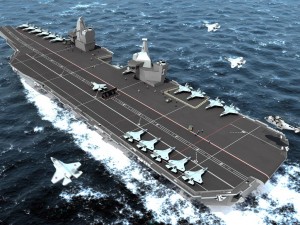 Credit: Aircraft Carrier Alliance – Queen Elizabeth Class at sea (CGI)
Credit: Aircraft Carrier Alliance – Queen Elizabeth Class at sea (CGI)
According to Wing Commander Butcher: “We are focused on the defense product, not the service one when it comes to the Lightning Force. It is important to do our business as a Lightning Force.”
The second front line F35B squadron, 809 Squadron, will establish at Marham and badged as a Royal Navy squadron with a RN officer in charge who could then relieved when the time comes by an RAF officer.
The fourth synergy is building the base while the three Tornado squadrons are operationally involved and on a busy schedule supporting RAF operations worldwide, notably in the Middle East.
This means that Tornado infrastructure not only needs to be maintained but not leveraged in any way until those squadrons leave Marham.
This means that the next Marham base Commander Group Captain Townsend will be charged with standing up the base for F-35Bs, the squadron arriving in two parts, and keeping the key strike function of Tornado operational until the very end.
It can be disruptive but the ops tempo of the base is the key determinant of the effort; not simply erecting new buildings for a new aircraft.
The fifth synergy is between the base and the new Queen Elizabeth Class Carriers.
The new carriers are coming on line concurrently with the base becoming operational and sea trials and preparing for the integration of the F-35 with the new carriers.
And this base will provide a key element of shaping the outreach from the UK into Northern Europe as well as Norway, Denmark and the Dutch Air Forces come on line with their F-35s as well.
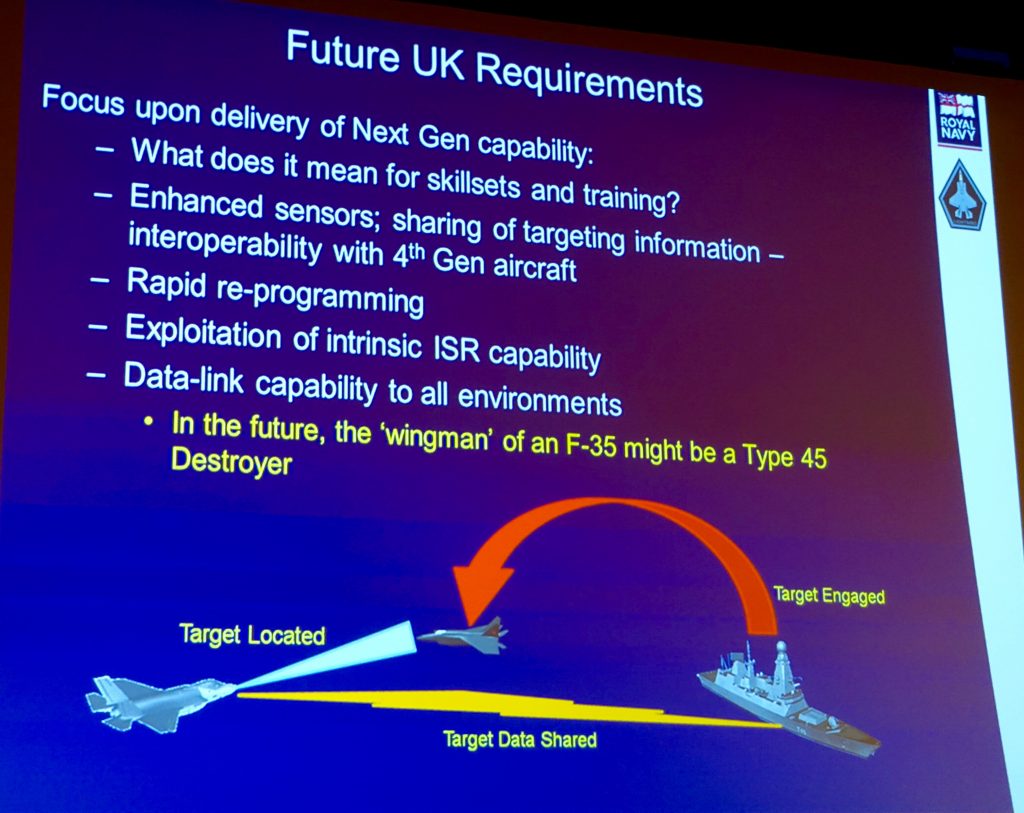 From Presentation by Captain Walker, Royal Navy, at the Williams Foundation seminar on Air-Sea Integration, August 2016
From Presentation by Captain Walker, Royal Navy, at the Williams Foundation seminar on Air-Sea Integration, August 2016
In other words, standing up the base at Marham is part of a significant strategic effort by the UK and at the heart of shaping 21t century approaches to deterrence.
When joined with what is happening from Lossie, to Iceland to Norway with P-8s, the upgrades to Typhoon, which will make it a core complement to the F-35B fleet and the reshaping of the ISTAR fleet at RAF Waddington, major changes are coming to the UK air and naval forces.
The rebuilding program itself is extensive.
Virtually all of the runways need to be repaved. And the modifications of the hangers would be so significant for the F-35, that it was preferable to tear down buildings and build new ones to house the new force.
As the head of the Project Anvil project put it: “This is one of the few projects I’ve been involved with where we have actually demolished buildings, cleared the site, and built new buildings rather than simply refurbishing old ones.”
The team implementing Project Anvil as it is called underscored that the schedule is demanding to get it done in time the arrival of the jets and the standup of the squadron. The focus of the effort currently is on what is called the FOA, namely, Freedom of Action enablers for the squadron – the runway, the maintenance and finishing center, the Integrated Training Center and the National Operating Center.
And the second phase of Project Anvil can only start after the Tornados leave Marham and preparations for the second squadron can put in place.
The team has worked hard to ensure that the capability can be delivered on time.
One example was working with the planning authorities in the region for the upgrades of the power grid necessary to support the F-35s. By providing information on very timely basis, the planning authorities were obtained and the project kept on schedule.
And all of this is being generated in a time of profound political change within NATO and in terms of the threats being faced by NATO. Clearly, an effective standup of capabilities at Marham and their integration into a broader defense effort is crucial for the defense of the United Kingdom and for its core NATO allies.
Captain Nick Walker provided a good overview on the challenges and the opportunities inherent in setting up a new joint base at Marham with the coming of the Queen Elizabeth class carriers.
“I think there is fantastic opportunity with the restructuring of MARHAM to create a truly world-class F35 facility. The investment in the infrastructure, particularly the National Operating Centre and maintenance facilities, will place MARHAM right at the fore of F35 operations and make it the hub in Northern Europe. Only Italy, with its Final Assembly and Check Out (FACO) facility at Cameri will come close to what MARHAM can offer.”
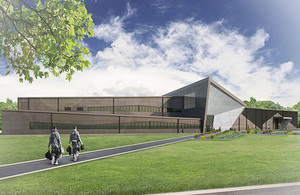 Computer Generated Image of the outside of one of the facilities which is being built at RAF Marham, Norfolk, as part of a programme of works to prepare the station for the arrival of the F-35 Lightning II fleet in 2018.
Computer Generated Image of the outside of one of the facilities which is being built at RAF Marham, Norfolk, as part of a programme of works to prepare the station for the arrival of the F-35 Lightning II fleet in 2018.
“And the fact that we are building it from new rather than modifying existing buildings really does present great opportunities to make the structure both future proof but more importantly design it from the outset to support multi-national F35 operations.”
“On the carrier angle, we have a similar opportunity. The UK is buying F35Bs, which are designed to operate from ships as well as land bases. The UK has determined to regenerate a carrier strike capability at the core of its power projection capabilities, and therefore we have purposely opted for an embarkable F35 variant.
“The carrier was then designed specifically to support F35B operations – the ‘aviation flow’ around the aviation, Carrier Strike Group and Intelligence planning and maintenance spaces has been very carefully thought through to ensure the best possible service and most efficient flow for the embarked squadrons.”
“Given that the design is now fixed and the nature of carrier construction means there is little scope for future alteration, we should take the opportunity to design the infrastructure at RAF MARHAM to emulate as far as possible the embarked flow and processes.”
“The F35B squadrons will spend a good proportion of their time embarked, and making the transition from ashore to afloat as seamless as possible just makes sense. The ‘shock’ of embarking is therefore reduced, processes are familiar rather than alien and the whole experience of taking squadrons to sea will be more efficient, safer and easier to manage.”
“It helps to make flying to and from the carrier as natural as flying at the Main Operating Base – the embarked elements become second nature because the ashore processes resemble them as closely as possible.”
“I accept that you cannot replicate a carrier at a land base, but given the MARHAM infrastructure is being designed from new, it makes perfect sense to build in as much commonality as you can.”
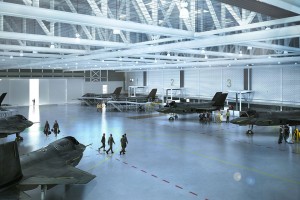 Computer Generated Image of the Maintenance and Finish Facility which is being built at RAF Marham, Norfolk, as part of a programme of works to prepare the station for the arrival of the F-35 Lightning II fleet in 2018.
Computer Generated Image of the Maintenance and Finish Facility which is being built at RAF Marham, Norfolk, as part of a programme of works to prepare the station for the arrival of the F-35 Lightning II fleet in 2018.
“A good example is the process of storing, collecting and returning the pilots’ helmets. This is done at a particular point in the pre-flight flow on-board, so it makes sense to have it at the same point in the flow ashore – the process is therefore the same both embarked and ashore.”
“The Lightning Force has looked at the helmet process on-board and will incorporate a similar process at MARHAM. Small things, but they do make a difference and keep the F35B Force aware of, and familiar with, their embarked processes as far as possible while ashore – it makes the return to sea smoother, familiar and safer.”
In short, the rebuild at Marham is at the heart of the modernization or indeed transformation of UK forces and a significant impact as well on allied thinking, including the United States.
